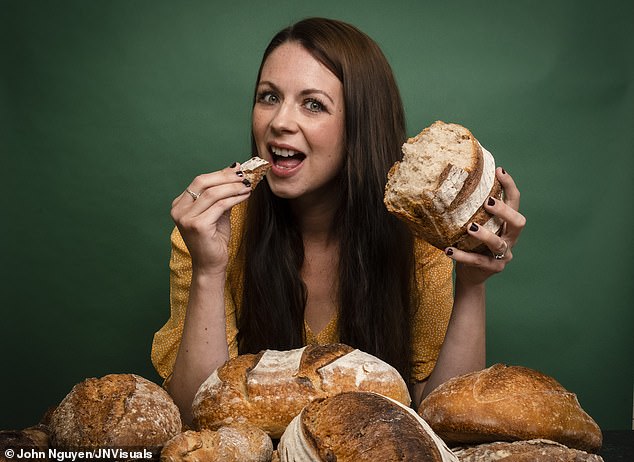Spread thick with butter, toasted with jam, or sandwiched around a prawn cocktail, there’s no denying it – we are a nation of bread lovers.
The average Briton eats 37kg of bread a year (the equivalent of 46 large sliced loaves), and collectively we buy 11 million loaves every single day.
But do you know what’s in the bread you are eating? Most of us have no idea – and a cursory look at the packaging won’t tell you much either.
Words such as ‘wholegrain’ and ‘freshly baked’ might sound impressive, but they have no legal definition, meaning manufacturers can use them to cover up a host of unhealthy ingredients.
Supermarket breads often contain dyes, preservatives and emulsifiers to make them look, smell and taste better for you than they are.
And the mouthwatering bakery smell that comes from crusty, super-soft loaves ‘baked in store’? Simply a distraction from the fact some of those loaves have been frozen in vast warehouses for up to two years, before being thawed and baked in bulk in a supermarket oven.

SARAH RAINEY analysed ten supposedly healthy loaves and five everyday white loaves – and found a host of hidden ingredients and nasties in most of them

Aidan Goggins, author and nutritional medicine director at wellness consultancy Kyros Project
Indeed, some of the loaves marketed as ‘healthy’ – for example with seeds or wholegrains, and often branded as ‘country style’ or with rustic-looking packaging – are in fact less healthy than a bog-standard white loaf. Even breads that purport to contain a limited number of ingredients aren’t always what they seem.
Earlier this month, the Real Bread Campaign claimed it had forced M&S into reviewing its labelling, after taking issue with two loaves from its new ‘Only . . . Ingredients’ range.
One of the M&S white sliced loaves, the campaign group said, claimed to have only four ingredients, when it actually contained 11. An M&S sunflower and spelt loaf featured a claim on the packet that it had just six ingredients, when it really had 13.
These are far from the only ‘healthy’ bread cons on supermarket shelves, however.
With the help of Aidan Goggins, author and nutritional medicine director at wellness consultancy Kyros Project, we analysed ten supposedly healthy loaves and five everyday white loaves – and found a host of hidden ingredients and nasties in most of them.
So, listed from best to worst, here’s what’s really in your daily bread . . .
Britain’s leading upmarket bakery churns out thousands of its popular sourdough loaves every day and, at 77p per 100g, they don’t come cheap.
This nutritious-sounding loaf is made from wheat and rye flours, white starter, malt, sunflower seeds, pumpkin seeds, sesame seeds and linseeds, before being rolled in more seeds to give it its characteristic crunchy crust.
‘It comes across as a real food,’ says Aidan Goggins. ‘The ingredients list is short, with no emulsifiers or propionate, which is added to bread as an antifungal acid, simply to keep it from going mouldy.
‘However, research now shows that, in the body, propionate consumption inappropriately activates the insulin counter-regulatory hormonal network, acting as a metabolic disruptor. This could plausibly contribute to insulin resistance, impaired glycaemic control and gradual weight gain over time.’
TOTAL INGREDIENTS: 8HEALTH SCORE: 9/10
Made with pumpkin seeds, linseeds and sunflower seeds, organic flour from Gloucestershire-based Shipton Mill, and a 25-year-old starter dough (rather than added yeast), this soft, chewy loaf takes more than 36 hours to make.
This, says Aidan, makes it a ‘true sourdough’ – unlike many pretenders on the shelves. ‘The slow fermentation activates natural enzymes that break down up to 96 per cent of phytic acid, the compound that normally locks minerals inside the grain,’ he explains.
‘Once that barrier is removed, our bodies can actually absorb more iron, zinc and calcium from wholegrains, something that fast-risen loaves can’t offer.’
As well as conferring digestive benefits, the loaf is high in fibre, containing 6.9g per 100g. The only downside, he adds, is the high salt content, at 0.94g per 100g.
TOTAL INGREDIENTS: 13HEALTH SCORE: 8/10
Fourth generation baker Jason Geary has cornered the market in mass-produced sourdough, using a genuine starter at its Loughborough factory.
The sprouted grains loaf is tangy, textured and combines a white sourdough base with spelt and rye. Of all the loaves we tested, it contains the fewest ingredients.
Aidan says the loaf has ‘initial advantages’ by combining sprouting and fermentation, which ‘work in tandem for easier digestion and better nutrient absorption’.
However, the ingredients list reveals it also contains ‘fermented wheat flour’, which Aidan says is a ‘clean label sleight of hand’. ‘It’s simply flour that’s been pre-fermented with bacteria to produce propionic acid, used purely for mould control and shelf life.’
TOTAL INGREDIENTS: 6HEALTH SCORE: 7/10
This loaf, from Sainsbury’s premium range, is wholemeal – not wholegrain – bread, and is ‘packed with seeds to give an irresistibly nutty and malty flavour’.
Aidan says the seeds make it ‘appealing’, as does the fact it’s high in fibre. But, like many nutritious-sounding loaves, it’s made with fermented wheat flour, which confers no nutritional benefits and is simply used to stop it going off. Palm oil is also an ingredient, which is not only high in saturated fat but also has environmental impacts.
TOTAL INGREDIENTS: 19HEALTH SCORE: 7/10
With the highest fibre content (a whopping 7.5g per 100g) and a wholemeal base, this loaf has a nutty flavour, with vitamin D for added health benefits.
But the ingredients include fermented wheat flour and emulsifier, making it what Aidan terms ‘a classic wholesome base given the industrial treatment’. As well as shelf-prolonging additives, the loaf contains 0.98g salt per 100g – high for a wholemeal loaf – and 2.2g sugar per 100g – the second highest of the lot.
TOTAL INGREDIENTS: 14HEALTH SCORE: 6/10
Though it may contain more than the four ingredients that are listed on the front of the packaging, this soft, crusty white bread isn’t a bad choice, says Aidan.
‘It also contains fermented and malted wheat flour and vitamin D yeast, plus there’s no emulsifier or propionate listed on the packaging,’ he adds. The fibre content, however – just 1.9g per 100g – is quite low, even for a white loaf, so it’s not going to give you many digestive benefits.
TOTAL INGREDIENTS: 7HEALTH SCORE: 6/10
This healthy-sounding loaf claims to combine a host of nutritious things: wild-farmed wheat flour, sourdough, sunflower seeds and spelt.
The flour has added calcium, iron, vitamin B3 and B1, but, says Aidan, ‘it’s marketed as minimalist, yet has added yeast and fermented wheat flour, which give it away as not a proper long-fermented sourdough culture.’ The spelt and seeds provide ‘modest nutrient density’, but are ‘cancelled out’ by the yeast and fermented flour.
TOTAL INGREDIENTS: 9HEALTH SCORE: 5/10
What you see is what you get with this basic Waitrose loaf – it’s a soft, sliced bread with a farmhouse-style floured crust.
It’s what Aidan calls a ‘straight white’, meaning it contains the expected additives: emulsifiers and calcium propionate to extend its shelf life and add flavour. There is, however, 3g fibre per 100g and, with just nine ingredients, it contains far fewer than many of the ‘healthier’ loaves we tested.
TOTAL INGREDIENTS: 9HEALTH SCORE: 5/10
Made with wholemeal flour, this loaf claims it’s ‘high in fibre’, as well as low in fat and a source of vitamin B1, good for nerve and muscle function.
The ingredients show additives and emulsifiers, as well as caramelised sugar. The latter gives it a very high sugar content – 4.1g per 100g – the highest of any of the loaves tested. ‘The macro nutrition is fine, but the processing profile drags it down,’ says Aidan.
TOTAL INGREDIENTS: 11HEALTH SCORE: 5/10
The cheapest loaf of the lot, this Morrisons bread makes no health claims on the packaging.
Though it’s packed with emulsifiers and preservatives, it’s surprisingly high in fibre (3.2g per 100g) and not as high as some others in sugar (2.8g per 100g) or fat (1.3g per 100g).
‘It’s not even attempting to “hide” the calcium propionate as it’s additive-rich in general,’ says Aidan. ‘It’s not trying to pass itself off as “clean.”’
TOTAL INGREDIENTS: 8HEALTH SCORE: 4/10
A budget everyday loaf, this Warburtons bread claims to be ‘high in fibre’ and ‘rich in wholegrains’.
Made from 100 per cent wholemeal flour, it contains 6.4g of fibre per 100g – both of which are positives, says Aidan. However, it also contains emulsifiers (E481, E471 and E472e) and calcium propionate (E282). ‘Higher emulsifier intake is now linked to higher rates of cardiovascular disease and type 2 diabetes,’ Aidan adds.
TOTAL INGREDIENTS: 13HEALTH SCORE: 4/10
Highly-rated by some health experts, this Tesco bread has a blend of ten seeds and grains – including malted wheat flakes, pearl barley, poppy, sunflower and pumpkin seeds, to give it a rich flavour and crunch.
But Aidan isn’t impressed: ‘The wholemeal base and seeds deliver useful fibre, but the softness is engineered with multiple emulsifiers, making it a proper ultra-processed food.’
TOTAL INGREDIENTS: 21HEALTH SCORE: 3/10
Trendy tiger loaves are everywhere these days, with their distinctive savoury crackled crust and soft, fluffy interior.
This claims to have been ‘baked in store’, a meaningless term as it may have been frozen first, then finished in a supermarket oven.
Aidan says it’s ‘firmly in the ultra-processed category’. ‘It uses less-commonly seen additives such as I-cysteine for high-speed industrial processing. What we can say with certainty is that this isn’t “real” bread.’
TOTAL INGREDIENTS: 12HEALTH SCORE: 3/10
This small loaf contains a range of healthy-sounding ingredients, from seeds and grains to a blend of pulses: green split peas, broad beans, red split lentils and chickpeas.
However, it’s little more than ‘great concept branding’, says Aidan.
‘The label lists multiple emulsifiers and propionate from fermented yeast flour. Its high protein largely comes from added wheat protein, not the pulses and seeds, so there’s some padding of numbers going on there.’
Not only does it contain the most ingredients of any loaf we tested, but among these are emulsifiers, palm oil and dextrose (a simple sugar).
TOTAL INGREDIENTS: 27HEALTH SCORE: 2/10
A ‘textbook ultra-processed food’, this loaf is a staple in many homes, but it isn’t doing you much good.
High in salt (0.98g per 100g), and sugar (3g per 100g), and with just 2.3g fibre per 100g, which is lower than most other white breads.
TOTAL INGREDIENTS: 10HEALTH SCORE: 2/10